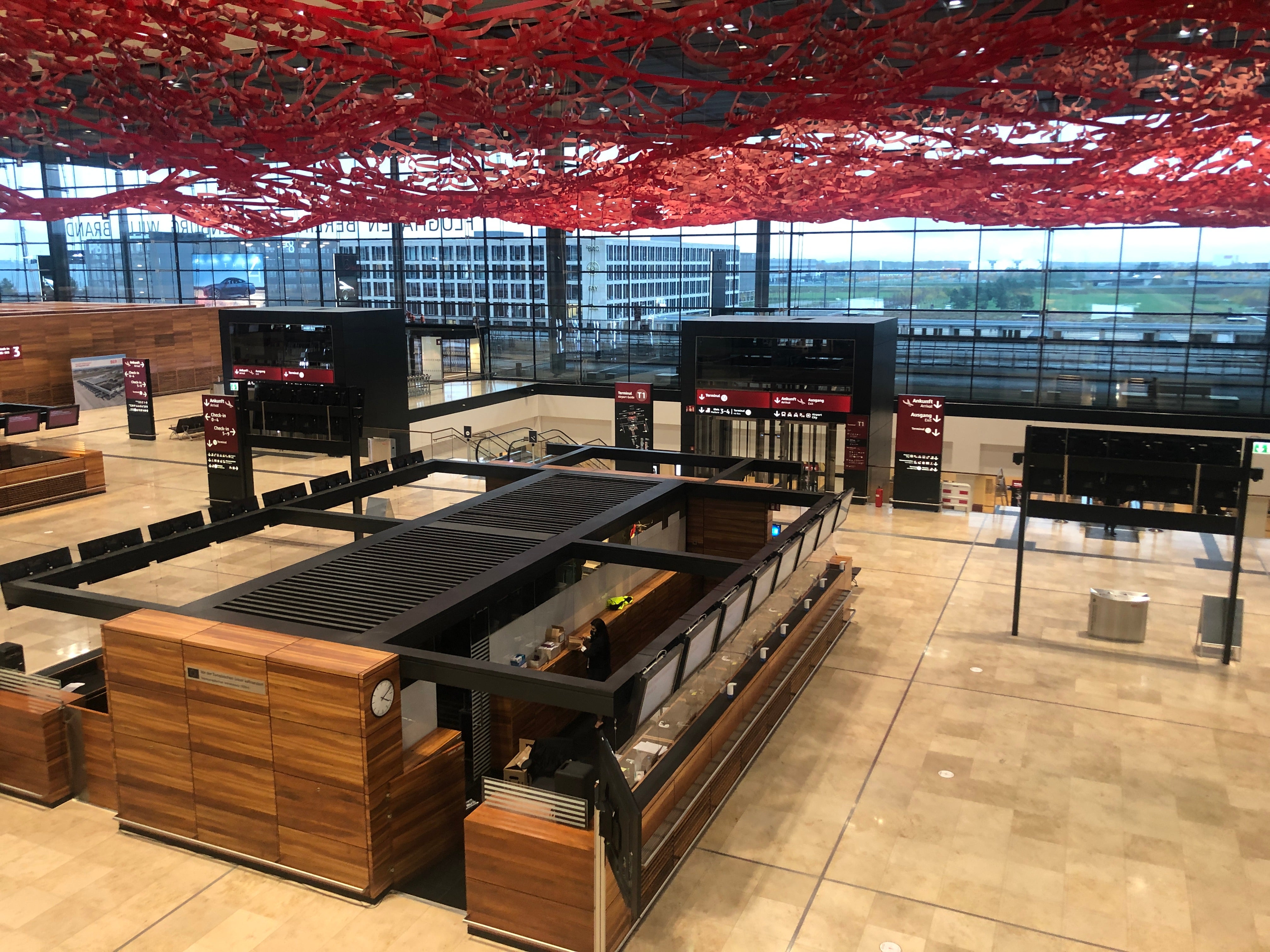Inside the world’s newest airport: Berlin Brandenburg
Simon Calder was on the first passenger flight to, and the first scheduled departure from, the German capital’s ‘new’ air hub


Your support helps us to tell the story
This election is still a dead heat, according to most polls. In a fight with such wafer-thin margins, we need reporters on the ground talking to the people Trump and Harris are courting. Your support allows us to keep sending journalists to the story.
The Independent is trusted by 27 million Americans from across the entire political spectrum every month. Unlike many other quality news outlets, we choose not to lock you out of our reporting and analysis with paywalls. But quality journalism must still be paid for.
Help us keep bring these critical stories to light. Your support makes all the difference.
Berlin Brandenburg Airport Willy Brandt (or BER for short) has opened to passengers, nine years late.
The first passenger flight arrival was a special easyJet flight from West Berlin’s Tegel airport – which will close within a week.
Since the first postponed opening date in October 2011, the ballooning cost of BER has been principally spent on putting right a structure that represented a reasonable definition of the word kaput. But at last, the largest building site in Germany has become a working airport.
Here’s what it’s like inside.
Why is ‘new’ in quotes?
Because much of the structure is a decade old, and because purists will argue that it constitutes simply a new terminal and runway added to an existing airport, Berlin Schoenefeld. Indeed, the first departure – easyJet to London Gatwick – took off from Schoenefeld’s original runway, which is now rebranded as the new airport’s northern runway.
Schoenefeld, with its Cold War vibe, continues to operate as Terminal 5 of BER, with Ryanair as its main tenant.
The new part is known as Terminals 1 and 2 (though only 1 is open at present). Terminals 3 and 4 are satellite terminals that are still on the drawing board and seem likely to stay there for many years, with passenger traffic hit so hard by the coronavirus pandemic.
What took so long?
The project was botched from the outset, with no figure in overall charge. As well as extensive legal action involving some of the parties involved, and much evidence of shoddy workmanship, at the heart of the delay were safety issues – in particular the fire protection and smoke exhaust systems.
In a desperate bid to allow the airport to open before the problems had been solved and while the necessary engineering work was completed, a perfectly serious proposal was considered to recruit a team of 700 human fire spotters.
Their job description was basically intended to be:
1 Watch for a fire.
2 If you see one, shout “Feuer!”
3 Tackle the blaze with a fire extinguisher.
Finally, though, the protection system was fixed and approved.
Where is BER?
About 20km/12 miles southwest of the centre of the German capital, just outside the Berlin city boundary in the state of Brandenburg – which explains the first part of the name. The second part honours Willy Brandt, former mayor of Berlin and chancellor of (then-) West Germany. His image is featured prominently on a wall on the arrivals level.
How do I get there?
Nicky Gardner, Berlin resident and co-editor of Europe by Rail, says the easiest way from the capital is on the dedicated double-deck FEX trains that depart twice an hour from Berlin Hauptbahnhof (main station), taking a shade over half-an-hour.
But a wide range of other trains, including fast InterCity services, serve BER airport from the capital, with the standard fare of €3.60 (£3.30) covering the journey itself and add-on transport anyway in Greater Berlin by bus, tram, U-Bahn (underground) and S-Bahn (suburban railway).
If you are heading for Terminal 5, note this terminal has a entirely separate station. The S9 runs every 20 minutes from Berlin Hauptbahnhof to Terminal 5, taking about 45 minutes. If you find yourself at the wrong station, a local bus shuttles every 10 minutes between Terminal 1 and Terminal 5.
As “Flughafen BER - Terminal 1-2” is a stop on the Regional Express and InterCity networks, you can catch direct trains to a wide range of destinations – notably Dresden, from which there are good onward connections to Prague.
What is the flight arrival experience like?
Smooth, with swift access to the main arrivals area. The only concern here is that the railway station is concealed underground and has no very obvious entrance: look for two sets of escalators.
You must buy a ticket from the machine, and stamp it, before heading for the correct platform out of the four on offer. It is usually platform 1 for central Berlin.
What is the departure experience like?
Reasonably straightforward in terms of wayfinding, though with a few bizarre shortcomings given that the airport has had years to get things right.
The main landslide departures hall is vast, with an interesting sculpture dangling from the ceiling – presumably to fill the space.
The security search area is cramped and inadequate; even with the trickle of passengers for the first flight on 1 November, it was clear that there was no easy way for travellers to repack their belongings.
When you emerge from security, there is no clarity about which way you need to head, until you find the departure screen some way to the left.
The retail and refreshment options are far better than Tegel, where the price of almost instant access from road to boarding gate was absence of shops and restaurants.
The duty-free offer has the usual suspects as well as an industrial-sized Jägermeister section for fans of this rather medicinal-tasting digestif.
The departure gates are spacious with plenty of seating and wide picture windows giving good views of the airfield.
But mains charging points are sparse, well-concealed and impossible to use while seated without causing a trip hazard. While there are recharging points with a variety of cables for phones, the devices cannot easily be used at the same time as they are charging.
With the main terminal located between the two runways, airfield congestion should be reduced – though the presence of the old Schonefeld airport as Terminal 5 will complicate matters.
Why have they kept Schonefeld open?
I asked the airport manager, Engelbert Lütke Daldrup, that very question. He said: “We took the decision before the Covid era. We had 36 million passengers in Berlin last year, and Terminals 1 and 2 do not offer the capacity.”
He added: “We could put Terminal 2 into operation tomorrow. But we will wait until spring 2021.”
Will BER be a super-hub like Frankfurt?
No. It was originally intended to be a major hub airport to rival Amsterdam, Paris CDG and London Heathrow. But Lufthansa has shown little interest in developing the concept, with the only destinations served from Berlin by the German national airline being its existing hubs at Frankfurt and Munich.
One of BER’s leading provisional customers, Air Berlin, went bust while waiting for the airport to open – thereby scuppering a plan for a Oneworld hub, involving British Airways and other carriers.
The main airlines are easyJet and Ryanair. But the most interesting carriers are Iraqi Airways, which serves as many destinations as Lufthansa – Baghdad and Erbil – and the Mongolian state airline, MIAT, to Ulan Bator via Moscow.
Weirdest domestic flight prize goes to Green Airlines, which intends to fly a 19-seat propellor plane to Baden-Baden, with fares starting at €119 (£109).
Any pleasant surprises?
Yes. As you walk from Arrivals to the rail station or pick up area, you pass a handy Rewe supermarket on the right, and on the left a fascinating museum/exhibition about aviation in Berlin. “Place for Flying,” as it is called, tells the whole mostly dismal story from the pioneering days, through the Second World War and Cold War, to the debacle of the delayed airport.
The publicity announces BER – vom Bau-desaster zum Flughafen: “from a construction disaster to the airport”. Admission is free.



Join our commenting forum
Join thought-provoking conversations, follow other Independent readers and see their replies
Comments